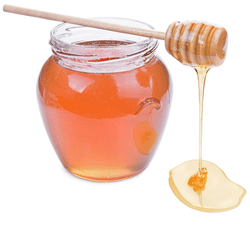Seasonal allergies are similar to environmental allergies in that they are caused by things that exist in your environment.
They differ from environmental allergies in that they only occur during the times of the year when specific allergens are in bloom. For example, ragweed allergies are common in the fall when that particular plant is in bloom, whereas dogwood allergies occur in the spring.
There are several remedies for seasonal allergies, including over-the-counter antihistamines, prescription medicines, but all of these remedies are designed to treat allergies after they start. Eating raw local honey can actually help prevent, or at least reduce the severity of, seasonal allergy attacks.
Honey bees collect nectar from flowering plants. These plants also contain the pollen that is the major trigger in seasonal allergies. Pollen is sticky and, as the bees fly from plant to plant, collecting nectar, the pollen sticks to their legs and bodies. The bees carry the nectar back to the hive where it is turned into honey. Because they also carry the pollen back, the pollen ends up in the honey.
When honey is collected, it can either go through a filtration and pasteurization process, or the apiary can package it straight from the hive, or raw. Raw honey still contains traces of pollen, and when you eat this honey, you ingest that pollen.
The theory behind the local honey remedy is that when you ingest the pollen it triggers an immune response. Because the pollen levels are so low, you won’t have a full-blown allergic reaction, it’s just enough to put your immune system on notice. If you eat the honey regularly, your immune system will eventually become desensitized to the pollen. When allergy season comes around, you will either have no reaction, or at least a less-severe reaction.
If you do have a reaction, local honey could help you respond better to allergy medicines. Additionally, using a specialized nasal spray can help flush pollen out of your nasal passages.
The honey must be raw, and it must be harvested from apiaries within your local area or from areas that have similar flora. This is because it needs to contain the pollen that you would normally encounter in your area. If you live in Cincinnati, OH, honey made in Philadelphia, PA might not have the pollen you need – but honey made in Bloomington, IN could.
Health food stores, and specialty stores like Whole Foods, often have clearly-labeled sections with local and raw honey. Even large chain stores are starting to have sections labeled with local products, including honey.
You should also make sure the honey is labeled organic. This will ensure that the nectar was not collected from plants that were exposed to pesticides.
It is good to start eating one or two teaspoons of honey per day at least three months before the pollen is in full bloom -- this will give your body time to build a resistance to the pollen. Your best bet is to eat the honey during the winter months when outdoor pollen levels are low.
You don’t have to eat it straight, you can put it in tea, spread it on toast, or use it in foods in place of sugar. The key is to start early in the year, to give your body a chance to develop a resistance.

0 Comments